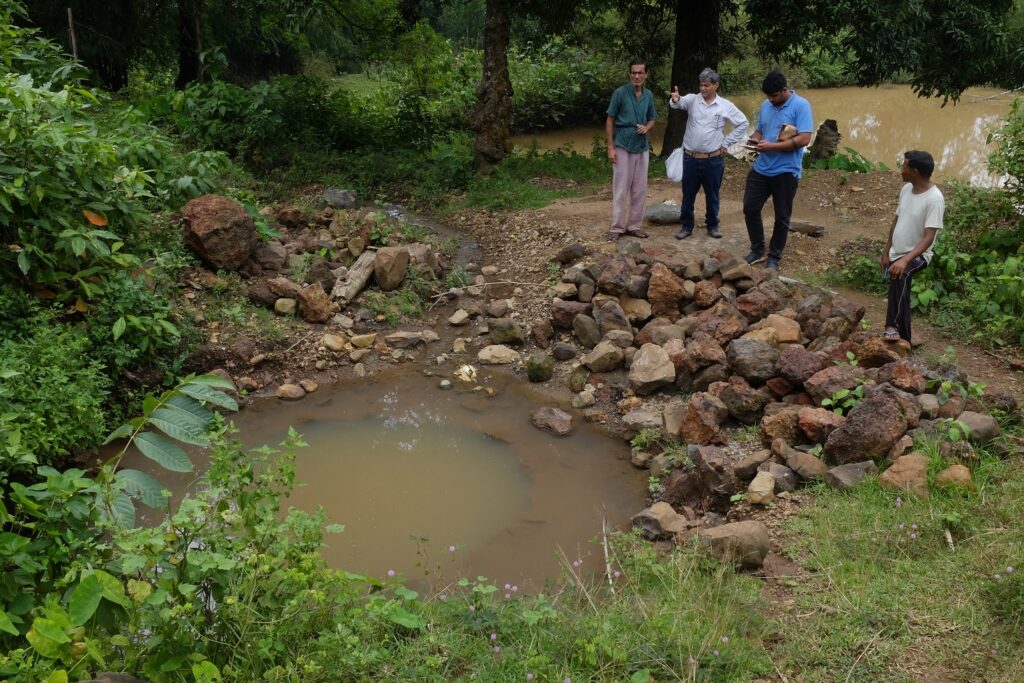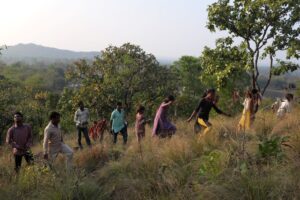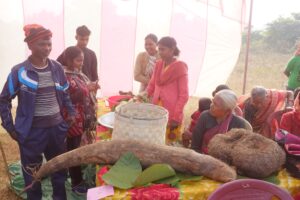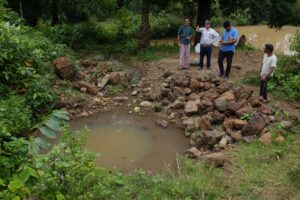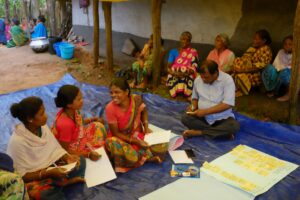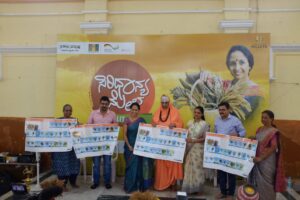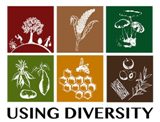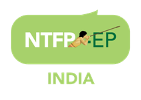Rohan Mukerjee, Soumik Banerjee, Shailendra Tiwari and Gokul Govind
In the last week of September, 2023 Rohan Mukerjee and Soumik Banerjee representing Keystone Foundation’s Eastern India initiative accompanied Shailendra Tiwari and Gokul Govind for field visits to Keystone Foundation’s project areas in Sundar Pahari Block, Godda District, Jharkhand and Purulia District, West Bengal to explore water related issues, challenges and initiatives in these areas and conduct associated training and capacity building workshops with local communities, community resource persons and local partner organizations in these areas. Shailendra Tiwari in through his long association with Seva Mandir, Rajasthan has worked extensively with community institutions on water and natural resource management principally in arid Aravalli Hills region of Rajasthan. Gokul Govind is currently Programme Coordinator (Community Wellbeing), Keystone Foundation based in Kotagiri, Nilgiri Hills, Tamil Nadu. He has worked with local communities in Odisha on a variety of water related issues and initiatives.
In Eastern India Keystone Foundation as a member of a number of networks and in collaboration with several regional organisations has been working on a variety of issues focused on community led conservation and management of ecosystems, Agroecology approaches and food sovereignty, biodiversity and natural resources; overall wellness and improved sustainable livelihoods of Adivasi communities. In 2021 Keystone Foundation’s Eastern India Initiative was established with the aim of enabling Keystone Foundation’s work in the Eastern region to evolve along the lines of the approach adopted in the Nilgiris and the Western Ghats, with adaptations made for the Eastern India landscape. At that time in response to concerns raised by local communities regarding issues pertaining to availability and quality of water especially drinking water, we launched efforts to explore and understand water issues, survey and monitor water sources and establish community run initiatives to ensure improved availability of water. The initial focus of our work has been the Paharia villages of Sundar Pahari Block, Godda District, Jharkhand and we are in the process of expanding the work to other areas like Kheria Sabar villages of Purulia District, West Bengal.
On the 26th of September 2023 the team accompanied by Surja Paharia (Field Staff), Community Resource persons Mahadev Paharia and Leta Paharia and community representatives visited water sources and sites in Bada Paktari Panchayat of Sundar Pahari Block where Solar powered domestic water supply systems have been established or are being set up through the Eastern India initiative. We first visited Bada Palma where a water supply system is in the process of being set up at Kandi Aamdu water source. We visited the water source where we met Jama Paharia a young villager who had an informal discussion with us.
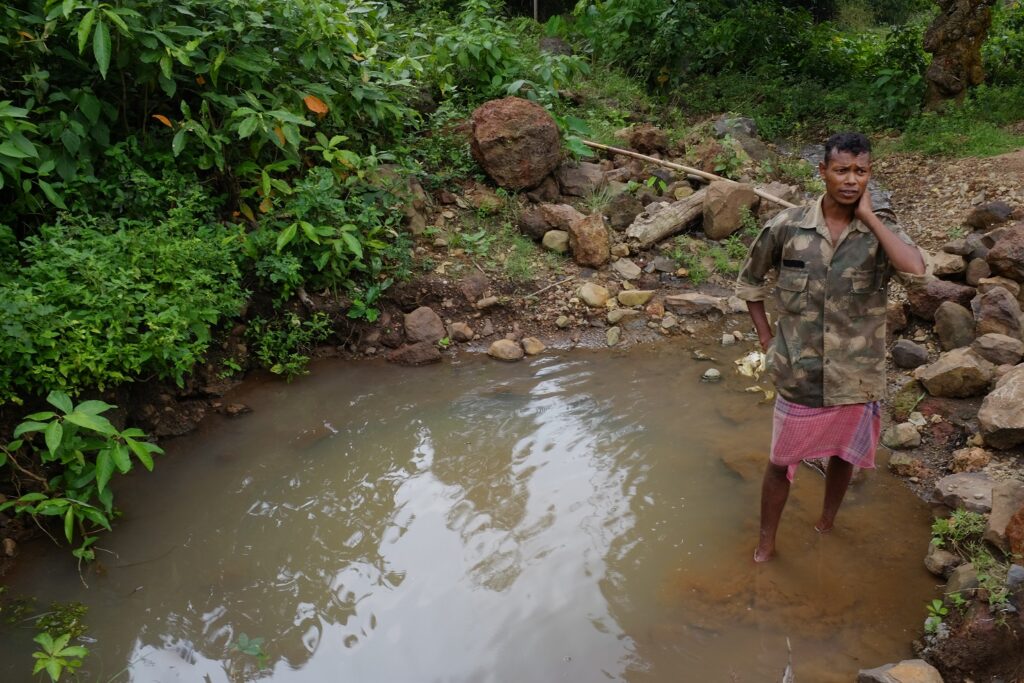
Jama was part of the team which was involved in the digging work to set up a well as part of the water supply system. He shared that when they were digging, they fund sand, mud and small stones at the bottom and there were no large rocks which made their work easier. Gokul pointed out that if the source was to be used for drinking water, then bathing and washing of clothes near the source would need to stop. Shailendra pointed out that open grazing in the area could be a possible source of bacterial contamination. These issues would be raised with and taken up by the community institution responsible for managing this source in the future.
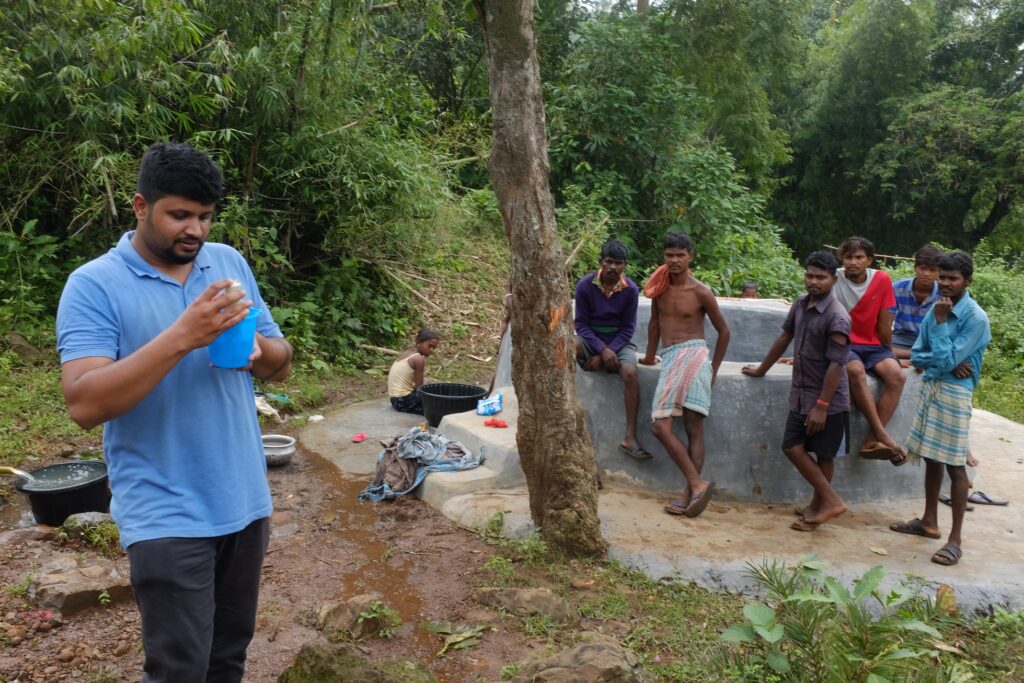
Gokul tested the water for a few parameters and the results were as follows – TDS – 83.4, Ph – 6.6 and Salinity – 60. This water source would be supplying water to 30-40 households of 3 Tola or hamlets of Bada Palma village.
We next visited Ghagra Jhola spring of Porkhani village which was the site of the first Solar powered domestic water supply system established through the Eastern India initiative in 2022. Due to a lightning strike one of the components of the drinking water supply system had malfunctioned and had been sent for replacement, and new part was received 27th September and replaced by Anil Kumar Dubey (Consultant Engineer). This water source supplies 40 households of 2 hamlets and CRP Mahadev Paharia resides in this village and has been monitoring parameters like Ph, TDS and Coliform for this and other water sources on a regular basis. Shailendra felt that the spring shed was in good condition and did not require any large scale interventions.
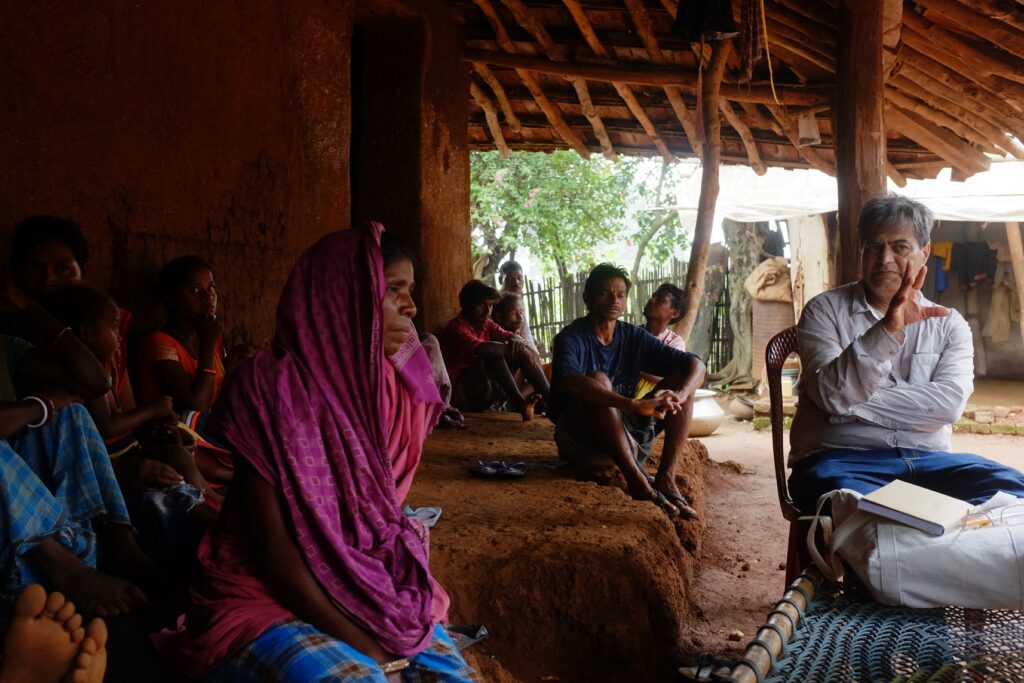
After inspecting the water source, we had a meeting with villagers chaired by the Pradhan Bameshwar Paharia. Bameshwar acknowledged the work done by Soumik Banerjee through PRADAN in their villages which started around 15 years ago which included forming of women’s Self Help Groups, pressurizing the Government to set up and improve roads and health care services. He said that it was always Soumik’s dream to get water to Porkhani village and he has achieved that. He said that in the future if they as a village and a community are able to remain united then they can work well and overcome the challenges facing them. With regards to the water supply system Bameshwar shared that they are in the process of setting up a separate area for bathing and washing clothes to ensure water being supplied to the village is clean and fit for drinking. Gokul introduced himself and asked if they have noticed any water related illnesses at different times of the year. The villagers shared that there is an increase in cases of diarrhoea which also could be linked to over consumption of Mango especially by children. Community Water Steward Mahadev Paharia shared that there are 3 principal springs which constitute Porkhani’s water sources – Doba Mo, Ghagra Jhola and Chapram Jhola. He said that for the Coliform tests conducted by him samples from Doba Mo have always come back black while for Ghagra Jhola the sample were black only once in a while. Chapram Jhola has hard rock at the bottom making it difficult to increase the depth. The villagers also shared that after seeing the success of the water system established with Keystone’s Foundation’s support and after repeated petitions the government has connected the Government well to the overhead tank with pipes. While these are positive efforts the government has not stuck to it’s plan of getting water from one of the springs close to the village and instead tapped a well where water level is already low and a matter of concern. Shailendra commended the efforts of the villagers and Keystone foundation in bringing water to the village. With regards to community led governance he stressed that there is a need for village level groups to meet regularly to discuss matters even when there are no serious issues of concern which helps build robust community institutions.
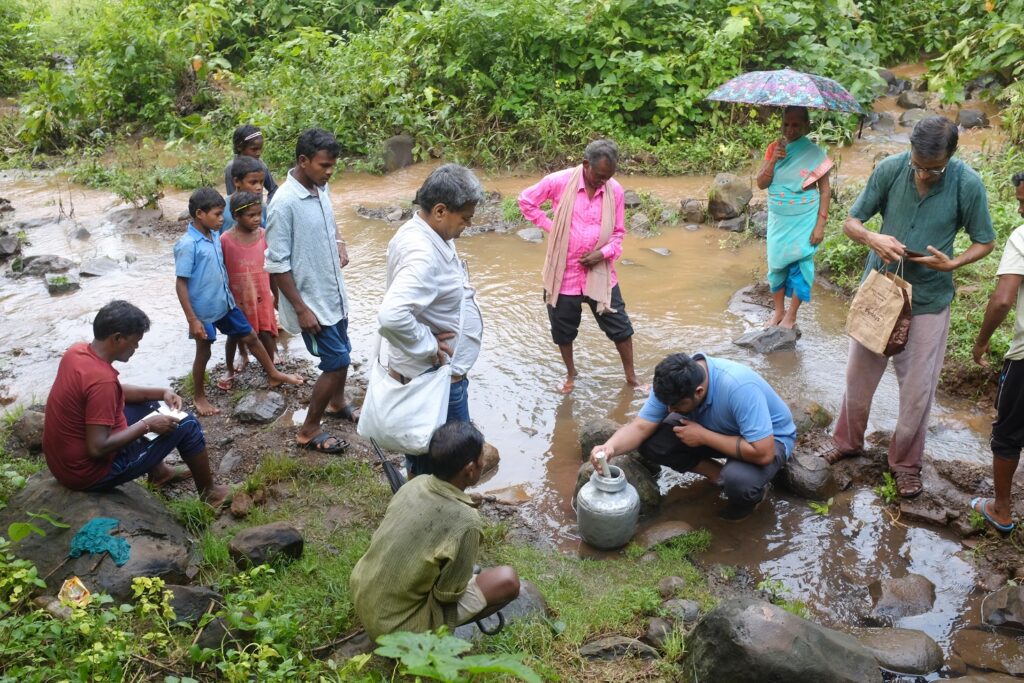
Next, accompanied by villagers Jama Paharia, Marega Paharia, Durga Paharia, Kali Paharin and Kepi Pharin we visited Madi Jola the primary water source of Rakha village. Gokul felt that the water source was either a depression or contact spring. Testing the water gave the following results – TDS : 95, Ph : 5.9 and Salinity : 66. The depth was only 2-3 feet and would have to be increased if a submersible pump was to be fitted as part of a solar powered domestic water supply system.
The day ended with a visit to the Paharia hamlet of Bada Paktari where the second solar based water supply system has been established. This system comprises a 2 HP water pump, a 10 feet deep well, 2010 watt (335*6) Solar panels, a and a 2000 liter water tank connected to the well through 472 metres of HDPE 1.5 pipe.
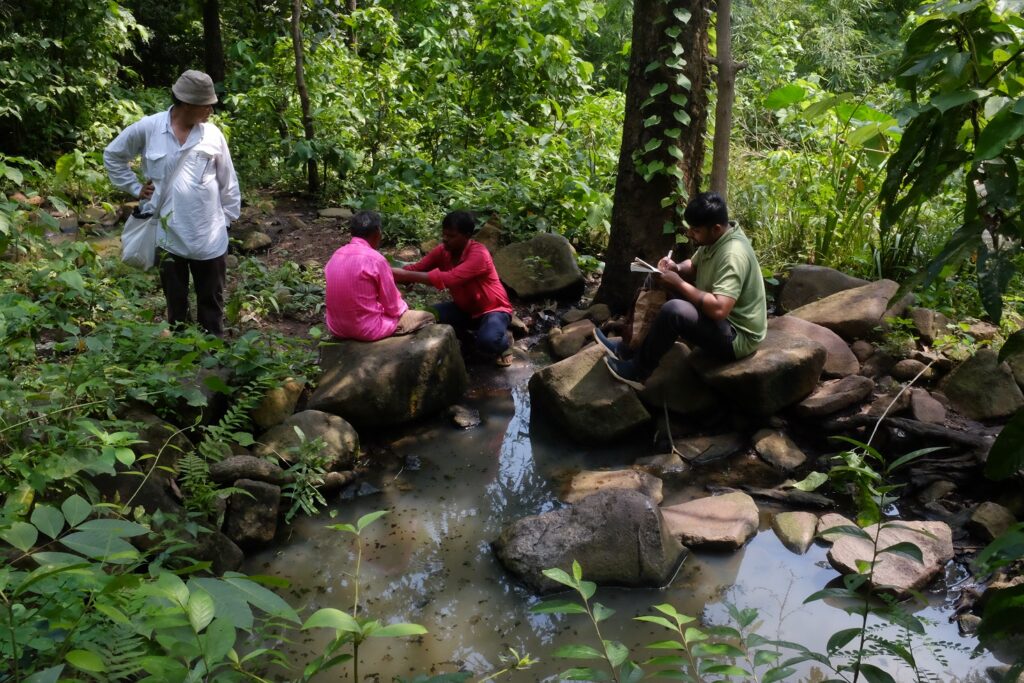
On the 27th of September before a community consultation at Ghagri village, we carried out an investigation of Ghagri’s sources of water. Ghagri faces considerable water scarcity issues especially in summer months. Drinking water is used from a spring in the adjoining village of Gadgama. For other domestic consumptions, there is a dug well and handpump within the village. The water level in the dug well drops in the summer season and hence there is a requirement for a perennial water source. Accompanied by Mahadev Paharia and Leta Paharia we visited a proposed source of water supply – Tangribeta Jhola. Tangribeti Jhola spring is located approximately 1 km distance down the slope of the village. The surveyed source appears to be a contact spring as there are multiple seepages on the horizontal line. The source needs to be cleaned and all washing, cleaning and bathing activities to be moved away from the source to prevent contamination.Recharge area: The slope above the source (and below the settlement) is its catchment area. Vegetation on the slope is critical for its sustainability throughout the year and all kinds of human activities will have impacts on its water quality, depending on the scale. Water quality tests –
● TDS – 121
● pH – 6.2
● Temperature- 28
● Salinity 82.5
The water is slightly acidic in nature as per the drinking water standards (6.5-8.5), which could be improved by relocating the bathing and cleaning out of close proximity. All other parameters are at optimal levels.
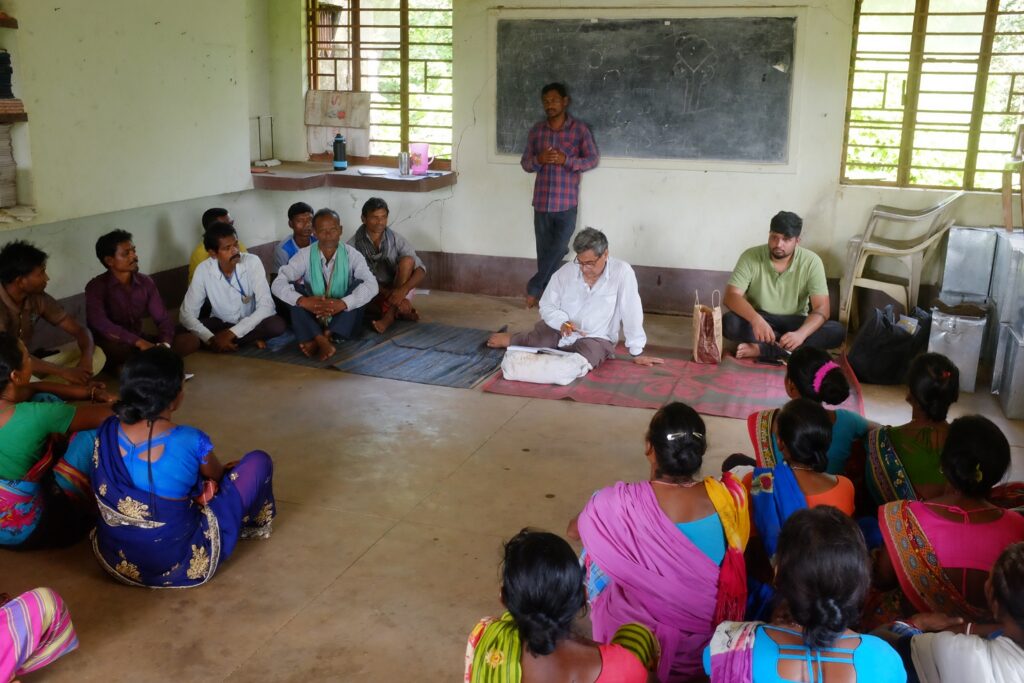
After our visit to Tangribeti Jhola we made our way to Ghagri Community Hall for a community consultation. The consultation involved 44 women and 11 men from 11 villages. Participants provided an overview of status of water and water related issues and challenges in their respective villages. Keys outputs of this sharing was as follows –
- Bada Palma – Dharmendra Paharia shared that they need to go more than 1 km from their hamlet in summer months to access drinking water. Bada Palma has 2 wells in the hamlets but water level reduces in the summer months. Two new wells have been constructed near their spring and one is part of the new Solar powered water supply system being set up by Keystone Foundation. The village has 2 tubewells but no water. Dharmendra reported that that in the early monsoon period there is a high incidence of dysentery and diarrhoea. The new solar drinking water supply system will serve 50-60 households of 3 hamlets. A Gram Sabha was conducted to decide where the new drinking water supply system would be set up and the hamlets to be covered.
- Rakha – While currently they don’t have any water problems, in summer months they face water scarcity. The primary water source is Madi Jhola (spring) which is around 1 kilometre away from their hamlet which is home to 22 households. The road to Madi Jhola is bad and is difficult to traverse in the evening. They have no well or handpump. There is a Jal Minar (Solar powered tube well based water supply system) in the Santal hamlet but it is far from their hamlet and the residents of the Santal hamlet stop them from using the Jal Minar. When they take livestock to Madi Jhola the muddiness increases. Since this is their only water source, they would like a Solar water supply system established here.
- Cheo – This village faces acute water scarcity problems especially in summer months and women have to bear the burden of sourcing water. They often need to go for water collection between 10 pm and 2 am to the spring – Ghagri Nadi around 1 km away. The route is steep and rocky making its especially hard to access the water source in the night. It takes a lot of time for the women to fill their utensils from a pipe connected to the water source. There are 3 tubewells but they have no water.
- Nathgoda – The access water from a Jharna (spring) around a kilometre away from their village. The water source dries up in the summer months making it harder for women to get water. In summer it is a common sight to see a line of women with utensils waiting to fill water. The village has no hand pump or well. The government has recently made a boring well but water is yet to start flowing.
- Chamdade –
- Neeche Tola (Lower hamlet) – On one side of the river there is a hole / depression from which they take drinking water. This fills up with silt when it rains. This is the primary source for the 22 households of this hamlet. The water source is around 1 kilometre from the hamlet and accessed by a small rocky sloped path that is challenging to traverse. There is no well or handpump in the hamlet.
- Upar Tola (Upper Hamlet) – home to 17 households has one well and an attached Jal Minar which enables them to meet their drinking and domestic water needs. They face problems with respect to water for their livestock.
- Dumli – home to 13 households they access water from Dumri Nadi which is around half a kilometre away from their hamlet. In summer months the flow reduces considerably. They have no wells or hand pumps. The government has started making a well near their water source. They have another source of water but it is very shallow and dries up in summer months.
- Balami – is home to around 55 households. In 2 hamlets. They have 7 handpumps but only 2 are working. They have wells, 1 in each hamlet, but they dry up in the summer months. They go to Madi Jhola spring which is around 1 kilometre away. Jama Paharia pointed out that a Keystone team had visited their water source in 2021 but is yet to establish a water supply system. This illustrates challenges posed by raising expectations when it is not possible to establish water supply systems in all villages simultaneously. But efforts are being made to establish systems in as many villages as possible with available resources.
- Ghagri – They have 2 handpumps but they are not working well. They have one well but it dries up in summer months. So they have suffer acute water scarcity in summer months when they have to go to the neighbouring village of Gadgama to access water.
- Gadgama – a Jal Minar was installed but the solar panels were stolen. They have 3 hand pumps but less water.
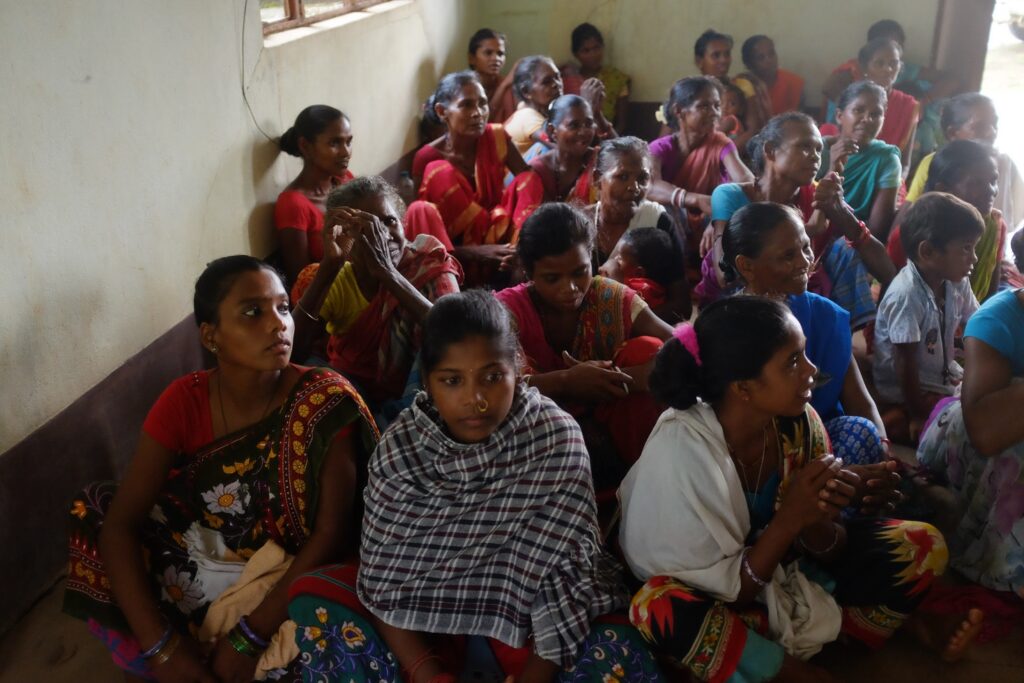
Gokul asked if they have witnessed any changes in the taste of water. Villagers from Cheo shared that taste of water from Ghagra Nadi ahs changed, it feels acidic / heavy when drinking. The participants shared that river water washes soap away fast but that is not the case with well water which takes longer to wash soap away.
Shailendra shared that there are also a lot of water issues in the areas he works in in Rajasthan. He emphasized the need for discussions between villages and a coming together of the community across the region to solve their problems especially in the context of water availability.
Purulia – 28th and 29th September 2023
On the 28th of September accompanied by Meghnad Sabar, Bishnu Sabar and Fatik Hembram from the Paschim Banga Kheria Sabar Kalyan Samiti (PBKSKS) team we visited a number of Sabar villages to explore and understand water related issues that they are facing. Some findings from the field visits were as follows –
Balokdih (sabarpada)
Households – 22 – 24. For drinking purposes 4 borewells were attempted in the village but none of them were successful. Villagers are currently depending upon multiple seepages along the paddy fields near the village. 3 sources were surveyed for water quality.
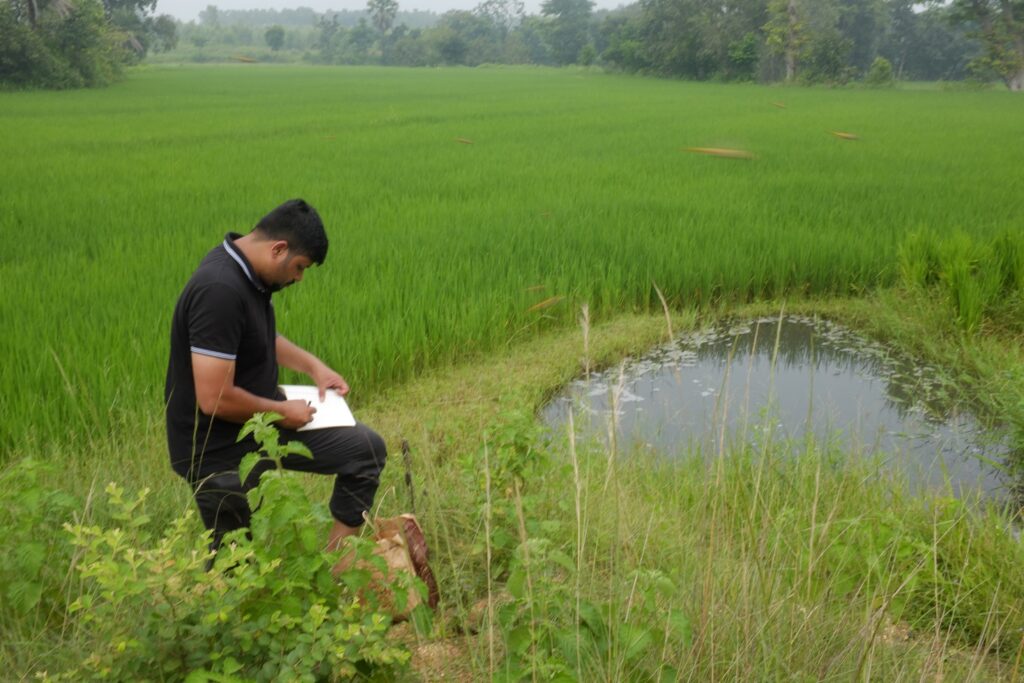
Source 1: The source flows for up to 7 months a year and hence is not perennial in nature.
TDS – 50
pH – 5.7
EC – 7
Temperature – 30
Though the source appeared to be visibly clean, the pH level measured is acidic as per the quality standards. Controlling the quality at the source level
Source 2: Water is available from the source throughout the year. The source appears to be the seepage from the paddy fields upstream.
TDS – 25
EC – 24
pH – 6.7
Temperature – 30.5
The source looks contaminated as open defecation was observed in the vicinity. In addition to this, the water from the paddy fields is in constant interaction with the seepage of the source, increasing the chances of further contamination. The source should be tested further for bacterial contamination.
Source 3: The source is located further upstream from the other 2 sources in the village. Location of the source is not in the midst of the paddy field like the other 2 sources.
TDS – 35
Salinity – 31
pH – 5.5
Of the tested quality parameters, pH is below the permissible limits.
All the sources in the village are within the drainage line of paddy cultivation. As the area has been under the usage of fertilisers for a long time, the sources are not a reliable source for drinking water. The entire area needs to be surveyed to identify a suitable source for drinking water.
Jabla (sabar pada)
The settlement has around 22 households.
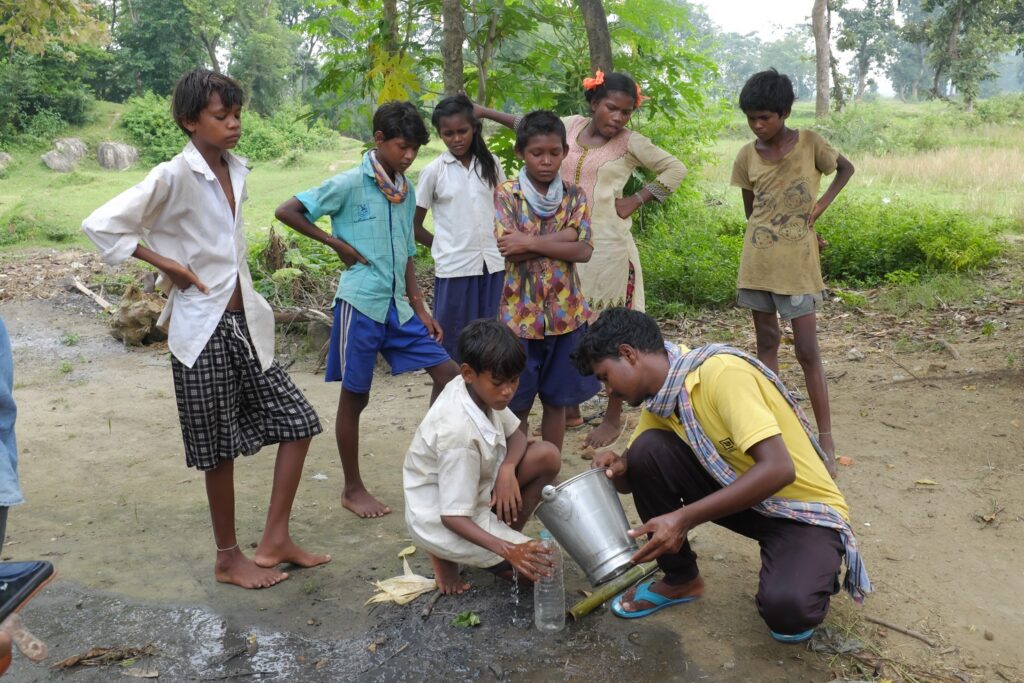
Source 1: Dugwell
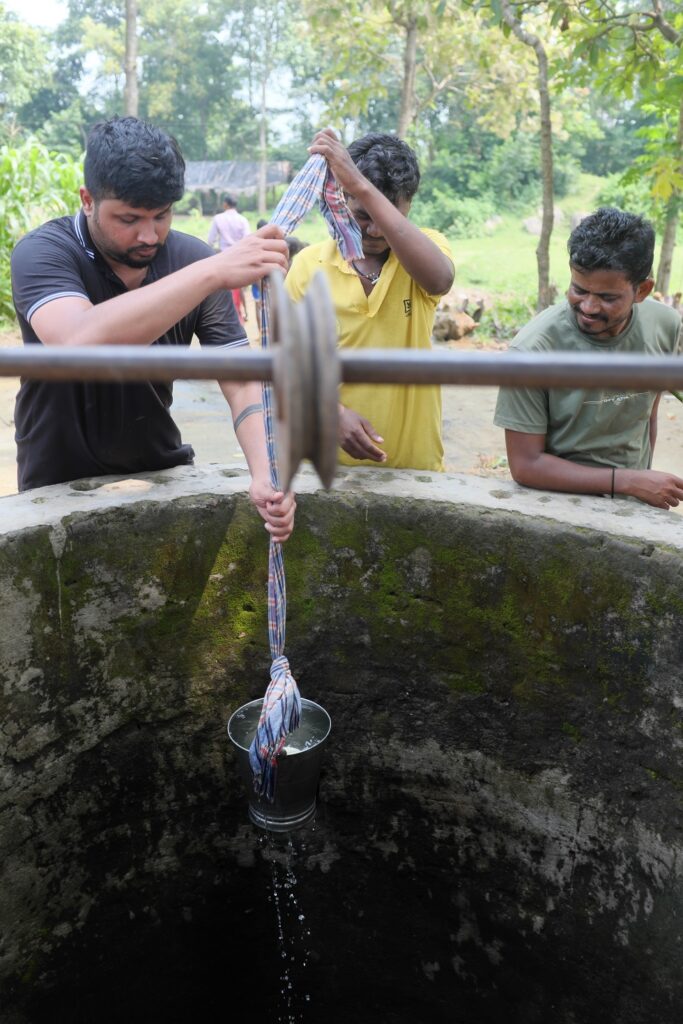
Located in the middle of the village, which is in the middle of paddy fields. The source is currently being used only for domestic purposes other than drinking as 2 people have fell in the well.
TDS – 923
Salinity – 627
pH – 6.9
Temperature – 28
The water from the source is extremely unsafe for drinking as both TDS and Salinity is beyond their permissible limits. A detailed laboratory test is recommended to determine the elements causing contamination.
Source 2: Jabla Jhore
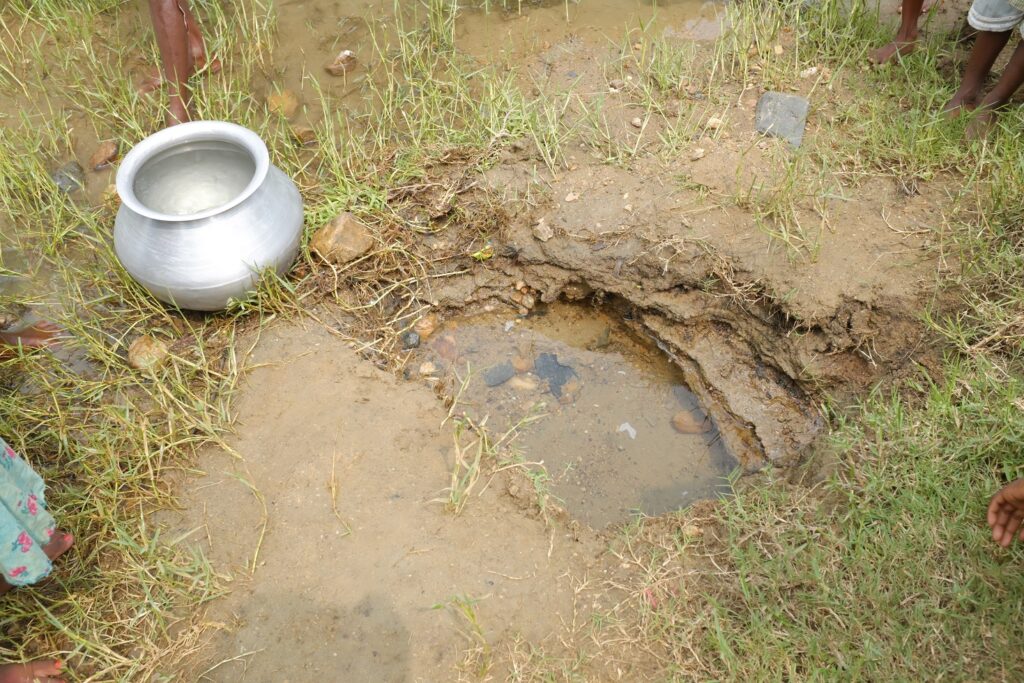
The source is located on banks of a stream. The villagers bathe in the stream and water from the seepage is used for their drinking needs. The source appears to be a seepage from the water flowing in the paddy fields above.
TDS – 19
Salinity – 128
pH – 6.2
The quality parameters seems to be in normal range and hence is currently safe. However, the source is prone to contamination given proximity to the stream and the paddy fields. Only frequent monitoring (including bacterial contamination) could help to judge its reliability in terms of quality.
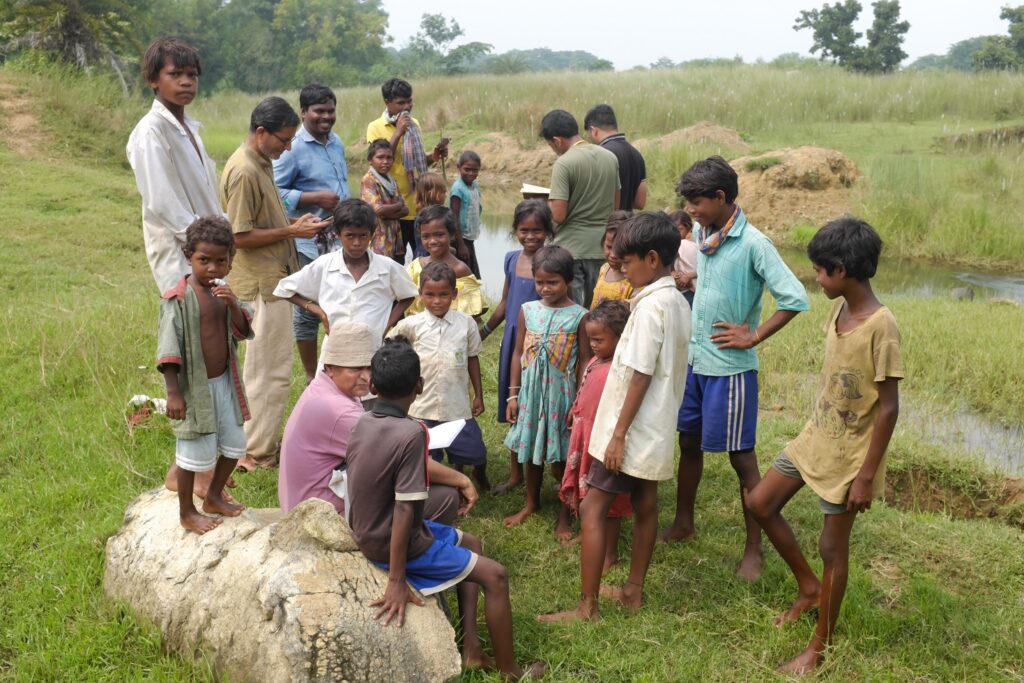
The village also has a handpump which has water available throughout the year. However, the villagers are not using it currently for drinking as the water tastes like metal. A thourough survey of the area is required to understand the geology and also to find a more suitable source.
The settlement has around 11 households. The village has 2 sources of water. 1 is a govt constructed Jalminar with borewell and the other one is supported by Keystone, drawing water from a seepage along a drainage line below the village. A collection chamber is constructed with closed mesh.
The entire village uses the water from the source for large gatherings and events in the village.
Source 1: Khedia dadi
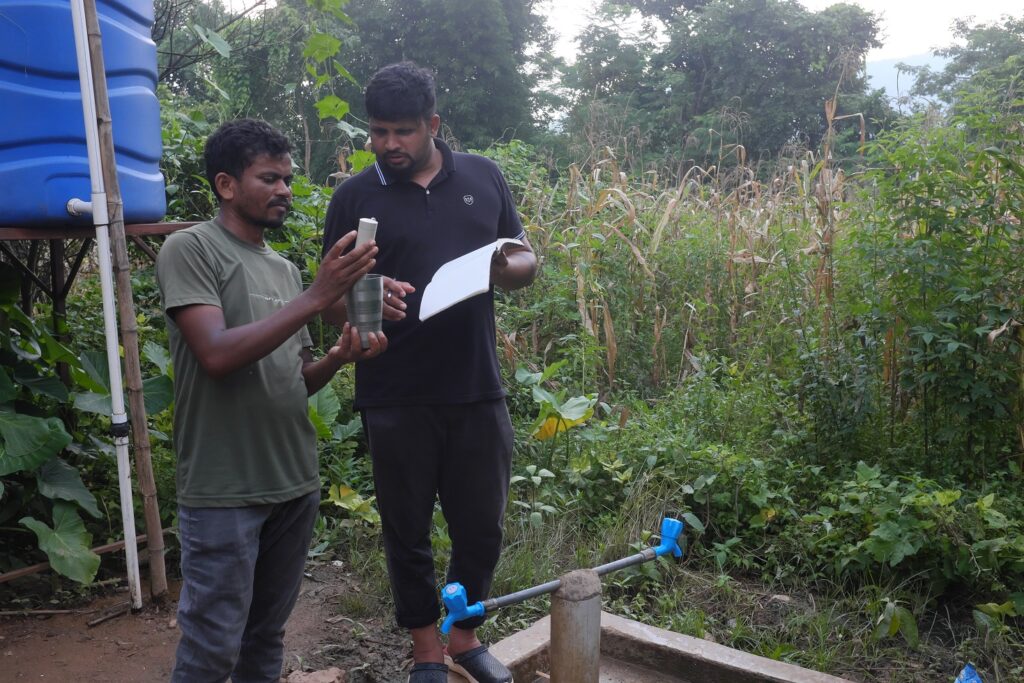
Currently the source is being used for drinking and other domestic consumptions.
TDS – 287
Salinity 191
pH 6.3
EC 404
Coliform – Positive
The water quality parameters are currently in safe range other than the EC (desired range is 400) which is on the borderline. The water from the source needs to be tested at a laboratory to understand the minerals causing the same.
Given the condition, the source needs to be monitored on regular frequency to track the changes parameters. The pond and the source enclosure also has to be cleaned on a regular basis to ensure good quality of water.
9 households are residing in the settlement. There are 3 sources in the village: 1 dugwell, 1 handpump and a spring. The dugwell was constructed with the support from PBKSKS few years back. Drinking water is drawn from the well.
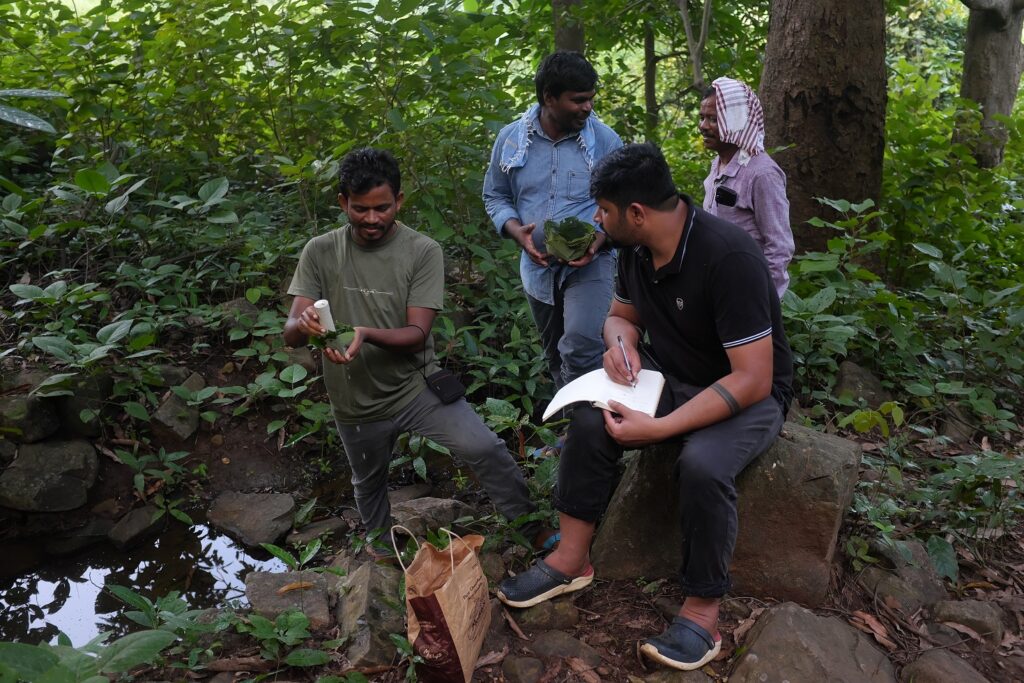
Source 1: Aam jharna
Aam Jharna is a perennial source. Type of the spring is depression as there are no immediate variations in the flow. As per the villagers, the flow has reduced over the last 2-3 years. The community does puja at the source on special occasions. The community is growing babui grass on the catchment over the last few years.
TDS – 371
Salinity 247
pH 6.2
EC 524
All the parameters except EC is within the desirable range. However, EC is higher than the desired limit of 400. The water from the source needs to be tested at a laboratory for detailed. Assessment. Meanwhile, the catchment needs to be surveyed in detail to check the reasons of contamination. For ensuring the sustainability and quality of water from the source, all the anthropogenic practices needs to be governed.
Source 2: Dug well
Community use the source for drinking and domestic usages.
TDS 432
Salinity 289
pH 6.73
EC – 611
The water from the source needs to be tested at a laboratory as the parameters are either borderline or higher that the desired standards.
Source 3: Handpump
Used for only domestic and other needs. Not used for drinking needs as it has high iron content. The source overflows during the monsoon season. Detailed tests to be done for the source.
29th September – Community Consultation and Training of Community Resource Persons
On the 29th of September we were joined by a team of 5 CRPs from Musabani and Potka Blocks in East Singhbhum District, Manoharpur Block of West Singhbhum District and Saraikela-Kharswan District of Jharkhand. They were accompanied by Jagabandhu Sanda who coordinates implementation of project activities in these areas. In the first half we had a consultation on water issues, community institutions and community led governance with members of PBKSKS’ Governing Body, Sabar community representatives, CRPs and the Jharkhand team. The program involved 30 participants. Prasanta Rakhit who has been working with PBKSKS for around 40 years opened the meeting and welcomed all participants. He provided a brief overview of PBKSKS and its work with the Kheria Sabar community.
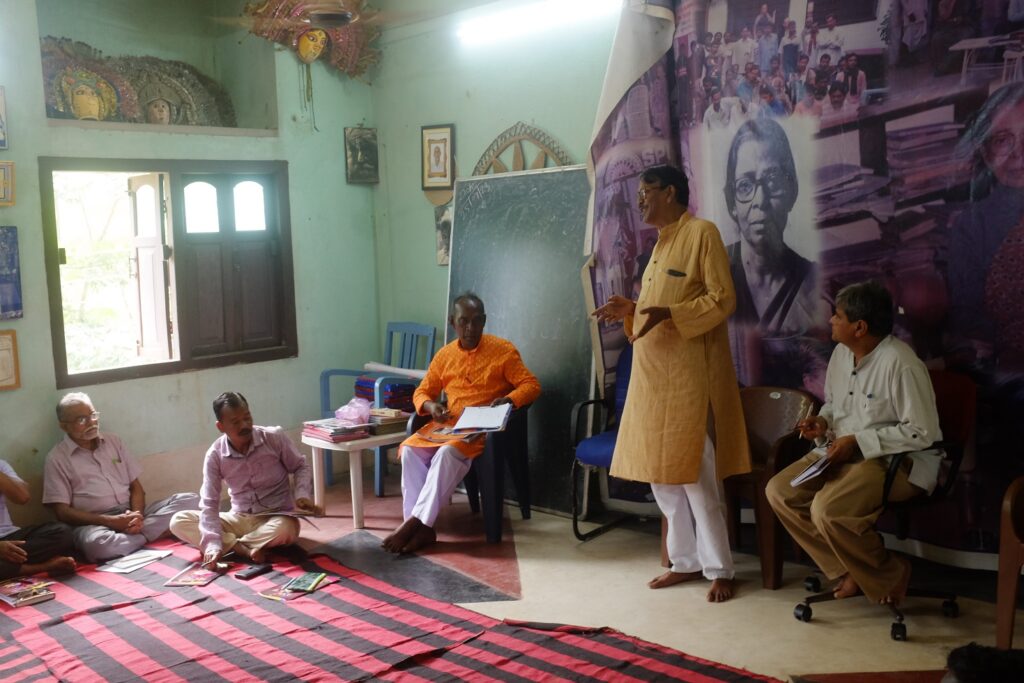
The PBKSKS is an NGO that had its inception as a community-based organization, and has been active in the area since the 1960s. It is the only NGO that works exclusively for the Sabars and has largely contributed to bringing into the limelight, this hitherto little-known, neglected and exploited community of people. The organization was born in 1968 on the initiative of Gopiballav Singhdeo (a member of the royal family of Panchakot, and a high school teacher) and his six Sabar associates with the intention of rallying the Sabars against their eviction from forestlands, to protest against social wrongs and to stop police atrocities in the name of a ‘criminal tribe’. The organization was rejuvenated in 1983 with the objective of ensuring minimum civil rights for the fragmented Sabar community, and came to be known as the Paschim Banga Kheria Sabar Kalyan Samiti; from this year onwards, the organization found a dedicated champion of its cause in the form of the well known social activist of the country, Mahasweta Devi.
Since late 2020 Keystone Foundation and PBKSKS have been working together on a number of projects with the Kheria Sabar people. The initial focus has been Agrobiodiversity, promotion of Agroecology and organic farming approaches, food sovereignty, wild and uncultivated food, sustainable natural resource-based livelihoods, forest rights and community led conservation and management of forests and natural resources. Based on participatory research and consultations with the local community we are now exploring water related challenges and potential community driven solutions. After the welcome by Prasanta Rakhit all participants introduced themselves and briefly outlined the work they are associated with and the challenges being faced in their areas with a focus on water related issues.
Shalaindra Tiwari then address the gathering sharing his observations from his field visit to Sabar villages and sharing his experiences with the building and strengthening of village institutions. Some key points from his session were as follows –
- He comes from a dry and arid area with considerably less greenery and trees than in this region. Here he saw greenery and lot of water but when he interacted with people he got to know that there are water issues especially for drinking water and in some places for farming. This is a matter of concern as despite the region getting rainfall the water is not being retained. He also heard that 2023 has been a year when rainfall was less and came late posing serious challenges to agriculture especially paddy cultivation. He feels that with climate change in the next few years this water scarcity might get even more acute, and communities need to prepare for these challenges and take necessary steps.
- Springs – he noticed the importance of springs as sources of water especially drinking water. But unfortunately they are under threat both in terms of quantity and quality largely due to destruction of forests, land use change and spread of modern chemical intensive agriculture which is contaminating water sources. Before wells and handpumps rivers, streams and springs were the main sources of water for local communities and they are still important sources but they are under threat and diminishing in many areas. Water routes and sources are making way for agriculture and forests destruction is also impacting water sources and overall availability of water in the region.
- Some wells are sources of drinking water but these are less and water quality of some of them is not good. Handpumps are present but many of them are not functional. In some areas even bore wells are not finding water and this is a matter of concern with respect to the status of ground water.
- Keystone Foundation started working on issues of Agriculture and forests and in response to people expressing a need for water based initiatives they have started exploring water issues and potential solutions to challenges being faced by the local communities. He feels that this work and have a positive impact on peoples lives and initial initiatives like that in Karru are already bringing positive results.
- He was impressed with work of village level leaders and workers who took work ahead in a good way despite challenges like COVID-19.
- He shared that all this work was carried out in a similar way by his organisation Sewa Mandir.
- He emphasised the need for taking this work forward through village institutions and shared some inputs on forming, building, strengthening and building capacities of village institutions.
- He referred to Mahatma Gandhi’s vision for our villages. If our villages are strong it means that they are self-reliant and don’t need to depend on external forces. Villages in the past had traditional institutions that resolved village matters and there were self-governance mechanisms and systems that were very strong.
- Earlier forests were referred to as villages forests but now they are called Forest Department (FD) forests. Also now land is privatised and there is virtually no more community land and common property resources. Traditional common property resources and associated management mechanisms have been eroded. Ownership and responsibility for most things has shifted from the village to the government.
- When natural resources like forests and water sources were under the village, they took responsibility for their management and protection. Now that it is under the government villagers no longer ownership and as a result in many cases the resources are suffering and so are the communities dependent on them.
- There is a need to reclaim community governance mechanisms and bring back village institutions and associated systems and mechanisms. Villages have experiences an increase in individualism at the expense of Collectivism and community feeling. Reviving community systems is hard but not impossible. Shailendra shared that good work is always considered hard. There is a need to return to the point where we lost our way and that could be symbolised by the “Gaon ka chaupal” where the village gathered in the past and which powered community decision making and governance.
- Shailendra shared that Sewa Mandir facilitated monthly village meetings on a fixed date to discuss different issues like health, education, village politics, etc. Time is limited now so meetings should be well planned and detailed minutes of the discussions should be maintained which can be referred back to in the future. There is a need for regular meetings and planning which build pressure and discipline to carry out planned work and helps strengthen village institutions.
- Decisions by village institutions should be based on mutual consent and take into account the opinions of all sections of village society.
- Village institutions can be scaled up to form cluster institutions (which can comprise representatives of 4-5 villages) and further a Federation of Cluster institutions can be formed which can take up big issues. He emphasised the importance of strength in numbers and unity.
- Shailendra also shared that Seva Mandir get the village community to contribute a percentage of the costs of any initiative like a Water Supply system. This can help form a corpus which can be used for repairs and maintenance and the interest can be used for village work. Villages they work with have established a Gram Vikas Kosh which is a form of sustainability fund used to carry out various village tasks and meet community needs. He pointed out that anything that comes for free is taken lightly and as a result is often poorly managed and falls into disrepair. Initiatives like Gram Vikas Kosh and village communities contributing a percentage of costs can help promote greater ownership of initiatives by villages institutions and communities.
Session on water issues, surveying, mapping and monitoring water sources and promoting community awareness and action for improved conservation and management of water resources – Gokul Govind
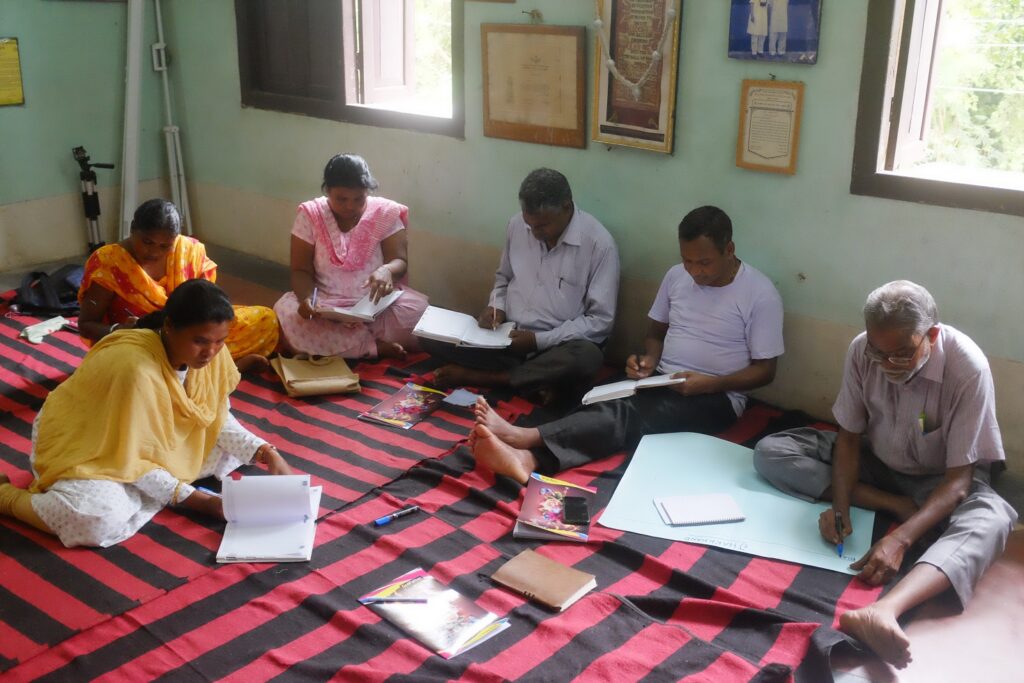
Post lunch Gokul conducted a session with CRPs, and representatives of PBKSKS. He started the session with a participatory exercise for which participants were divided into 2 groups (1 for West Bengal and one for Jharkhand) and they had to identify village level water challenges and possible solutions.
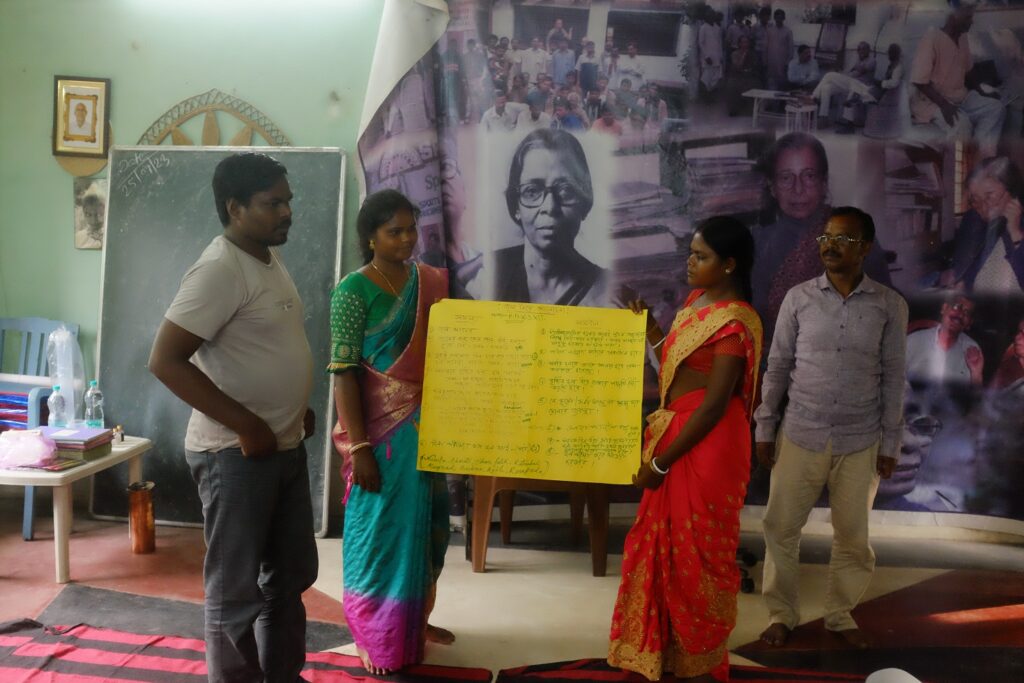
This helped set the tone and highlight key issues being faced with regards and after this Gokul conducted the session where he outlined key issues with regards to water, provided a hands on session on monitoring and surveying water sources for different parameters and covered use of participatory tools. A summary of the session is as follows –
Topics covered:
· About Water cycle, weather and different sources
· Impact of climate on the groundwater water sources
· Need for source monitoring and management
· Water source monitoring and demonstration
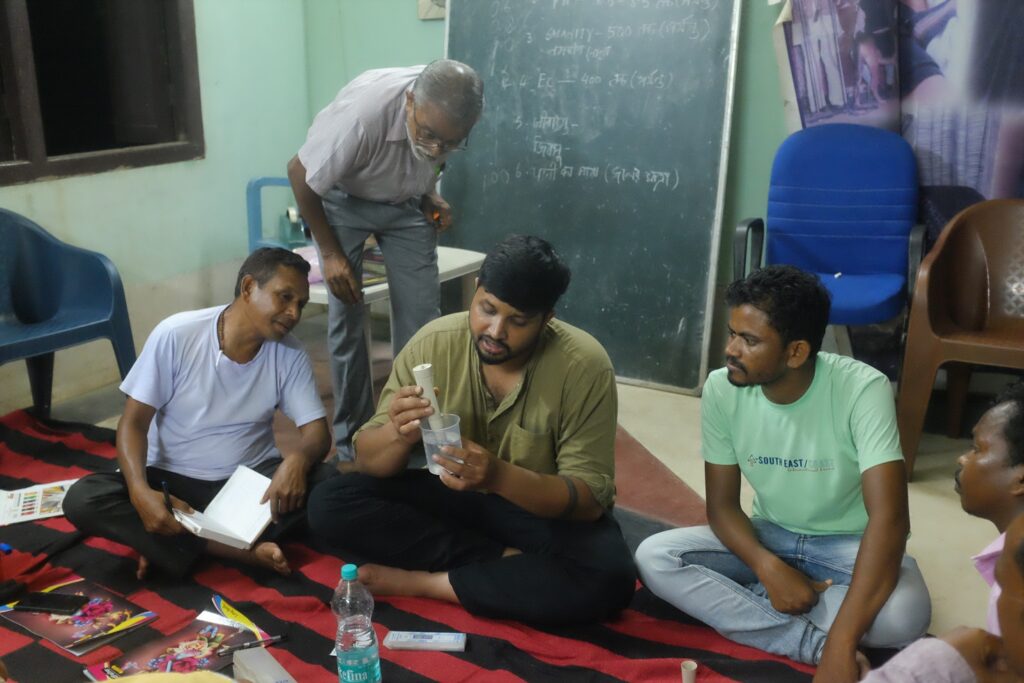
o Water quality – TDS, Salinity, pH and bacterial contamination
o Discharge measurements
o Weather parameters measurement – Rain, humidity and temperature
· Participatory mapping of the sources, catchments and other factors around the settlements.
Observations:
a. Participants were eager to understand the relationship of the water sources with the climatic conditions as they have had first-hand experience to relate.
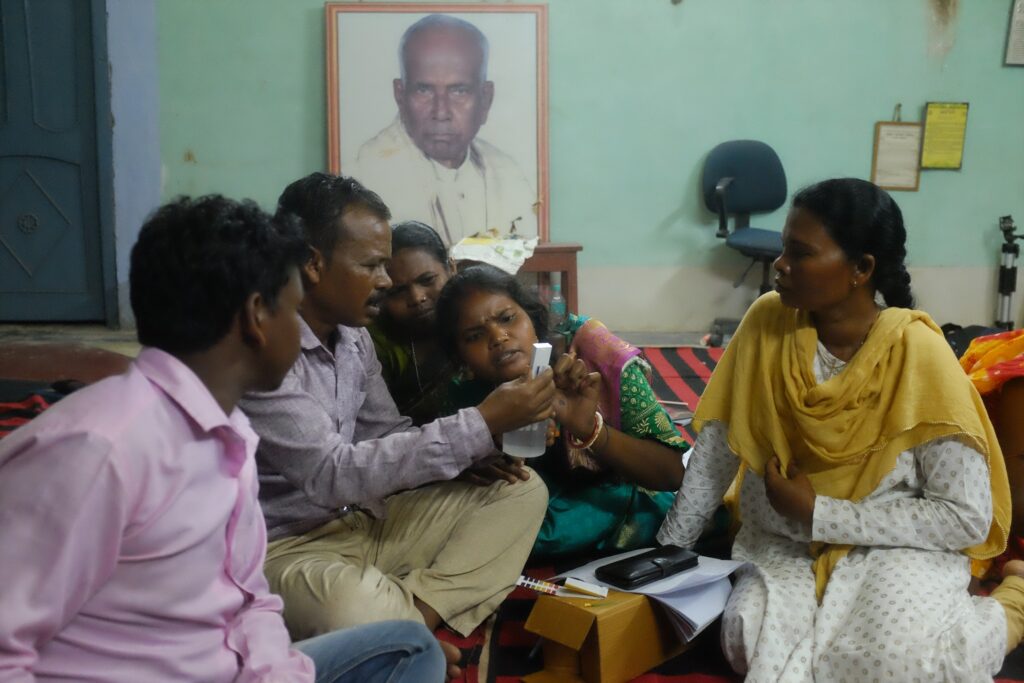
b. Response on quality measurement and its management was received well as they understood the conditions of their water sources and their need
The end of Gokul’s session marked the end of the 4 day Water program in Eastern India. This field visit and the associated workshops have laid the platform for building on Keystone Foundation’s initial forays in the field of water, water security and community water led conservation and management. We aim to continue to build capacities of CRPs, local organisations, community representatives and village institutions to come together to monitor, understand and address the water related challenges being faced by local communities.

